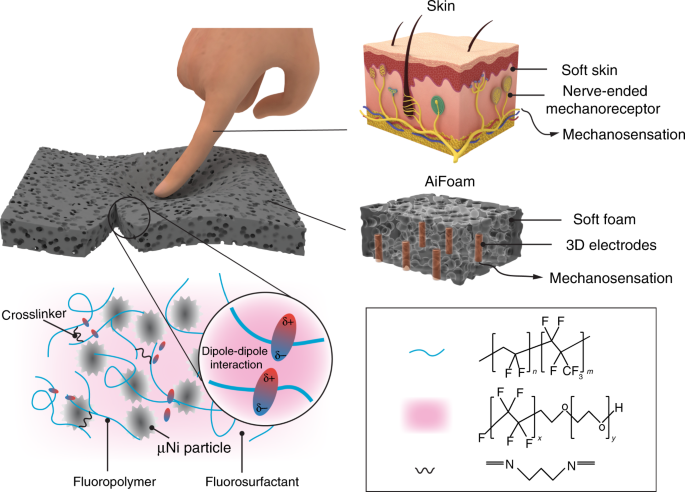(NUS researchers create AiFoam for robots to interact intelligently with their surroundings)
2021/5/10 シンガポール国立大学(NUS)

・ NUS が、人間のものと同様な触感覚を機械に付与するスマートな材料の「AiFoam(artificially innervated foam)」を開発。
・ 人工知能(AI)の進展によりロボットや機械のスマート化が促進されているが、微妙で複雑な周囲環境を人間のように感知する能力に欠ける。
・ 2 年間をかけて開発した同材料は、スポンジのような柔らかな感触で人間の触感覚を模倣。近接するオブジェクトを接触無しで感知し、損傷した場合には自己修復する。これらの両機能を世界で初めて同時に備えたスマートな同新材料は、より賢くインタラクティブなロボットの実現を可能にする。
・ 人間の触感覚は、不慣れな環境でのオブジェクトの操作や効果的な立ち回りにおいて不可欠なもの。このような触感覚を持つロボットでは、安全・予測可能で滑らかな機械的挙動が可能となる。
・ 例えば、クリーニングロボットやロボットウェイター等が離れた場所に居る人間を感知し、その情報から意図を推定できれば、より迅速に反応して特に混み合った場所での人間への衝突を回避できる。
・ オブジェクトに接触して圧力を感知する高度な電子スキンが開発されているが、近接するオブジェクトの動きの方向を検出できない。本研究では、このような技術的課題に対処した。
・ AiFoam は、フルオロポリマーとして知られるテフロンのような物質と表面張力を低減させる界面活性剤を混合した、230%の長さまで引き延ばせる高伸縮性のポリマー。これに金属粒子を注入し、オブジェクトの感知機能を付与した。
・ 同材料の柔軟性は、空気と材料の割合を変えることで制御できる。シリコーン等の電子スキンで一般的に利用される材料や、誤検知が起こりやすい光や反射を利用した近接センサーに比べ、人間の存在をより効率的に検出。数 cm 先の人間の指も感知できる。
・ 同材料の表面下に埋め込んだ円筒形の電極が人間の皮膚の神経終末を模倣し、加わった力の量だけでなく方向も検出するため、より迅速で適切なロボットの反応が可能になる。損傷した場合は、4 日間の 70℃での加熱で約 70%を回復し、約 2 倍(180%)の長さに引き延ばせる。
・ 現在、ロボット製造業者との提携と、人間と機械のシームレスなインタラクションの実現に向けたロボティクスや、人工義肢等の同材料の活用分野の拡張について調査している。
URL: https://news.nus.edu.sg/nus-researchers-create-aifoam-for-robots-to-interact-intelligently-with-their-surroundings/
<NEDO海外技術情報より>
(関連情報)
Nature Communications 掲載論文(フルテキスト)
Artificially innervated self-healing foams as synthetic piezo-impedance sensor skins
URL: https://www.nature.com/articles/s41467-020-19531-0
Abstract
Human skin is a self-healing mechanosensory system that detects various mechanical contact forces efficiently through three-dimensional innervations. Here, we propose a biomimetic artificially innervated foam by embedding three-dimensional electrodes within a new low-modulus self-healing foam material. The foam material is synthesized from a one-step self-foaming process. By tuning the concentration of conductive metal particles in the foam at near-percolation, we demonstrate that it can operate as a piezo-impedance sensor in both piezoresistive and piezocapacitive sensing modes without the need for an encapsulation layer. The sensor is sensitive to an object’s contact force directions as well as to human proximity. Moreover, the foam material self-heals autonomously with immediate function restoration despite mechanical damage. It further recovers from mechanical bifurcations with gentle heating (70 °C). We anticipate that this material will be useful as damage robust human-machine interfaces.



